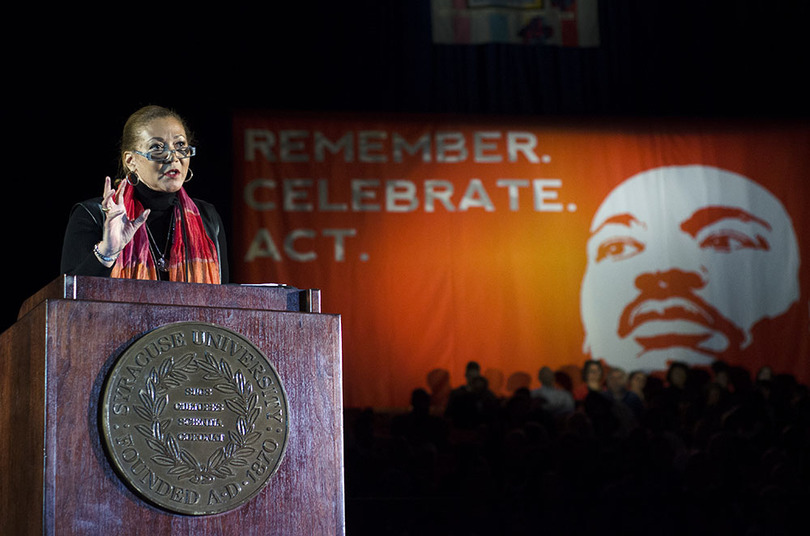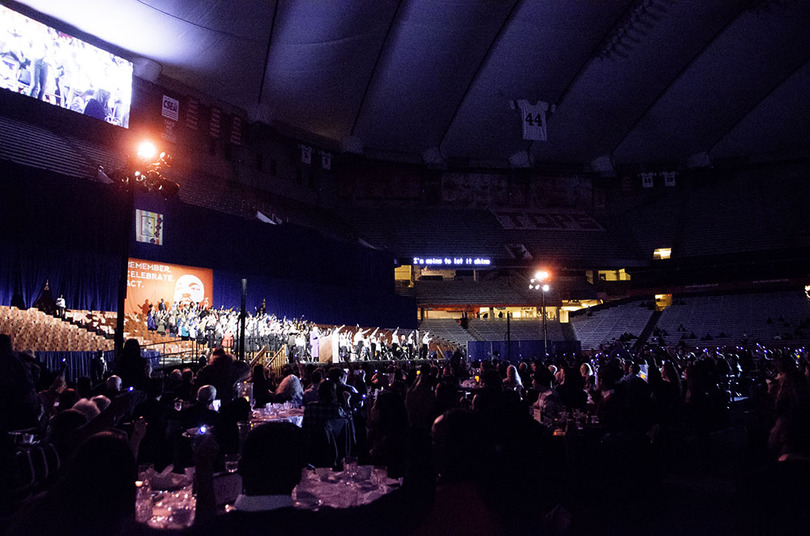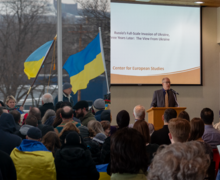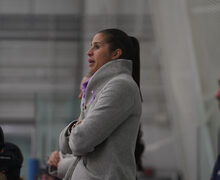SU students and community commemorate Martin Luther King Jr. at 30th annual celebration
Fifty years ago, Martin Luther King Jr. helped guide civil rights leaders and thousands of community members across the Edmund Pettus Bridge in Selma, Alabama, as they fought for the right to vote.
Speaking in the Carrier Dome on Sunday, Michele Norris reminded the crowd of almost 2,000 attendees that many people are still crossing that bridge.
Norris, a National Public Radio correspondent and creator of The Race Card Project, spoke to Syracuse University students and community members as a part of the 30th Annual Martin Luther King, Jr. Celebration. The theme of the event was “Remember. Celebrate. Act.” and featured performances from local and student dance, music and spoken word groups.
Attendees spent the first half of the evening enjoying dinner and chatting at tables that spanned half of the Carrier Dome field. On each table was a postcard from Norris’ Race Card Project, which encourages people to candidly describe their experiences with race and cultural identity in six words or less.
Throughout her speech, Norris tried to unpack King’s legacy and how it informs the current dialogue of race in America.
The bridge in Selma is a metaphor for America’s hopes and efforts to reach a society where all races and identities are accepted, Norris said. Much like the protests in Alabama, Norris said the bridge cannot be crossed once — it must be crossed again and again to keep the past fresh in our minds.
“The metaphor helps us understand that when we’re trying to move forward, the past is always there for us — a difficult past when you’re talking about race in America,” Norris said.
Norris broke in the middle of her speech as she was joined by the Say What ensemble, a group of SU students. For almost 30 minutes, Norris and members of the group read stories submitted through the Race Card Project.
“Suit? Degree? Still afraid of me,” one card read. Another said, “I’m fortunate to be Caucasian.” Some cards addressed stereotypes directly, stating, “Please stop saying that I’m articulate.”
Today’s youth are thought of as the first post-racial generation, Norris said. But this label suggests that we have moved on from a history of racism, she said.
Norris noted the difference between a post-racial generation and the post-racist society she believes we actually live in. The comment garnered overwhelming applause from the audience.
“Post-racial is an interesting word, because the aspiration suggests that racism is no longer important and we can take the express elevator up to the top floor where everything is wonderful and no one will make you feel icky or uncomfortable,” Norris said.
Denying the past ignores the progress we’ve made as a society, she said. Invoking the audience to look around at their neighbors, she reminded them that as little as a few decades ago, it would be illegal to have such a “tapestry of colors” in attendance.
Growing up in the 1960s, Sylvia Langford, chair of SU’s 2015 MLK Celebration Committee, said she thought her generation had accomplished everything that needed to be done to realize equality.
But thinking back to when she was involved in many lunch counter sit-ins, she said she realized there is more that needs to be done and that people should be proud to be a part of two races: the ethnic race and the human race.
“I used to hear young people talk about, you know, why don’t we have our own civil rights movement?” Langford said. “Young people have their civil rights movement. They’re not going to call it that, but it’s just as critical that young people are activists.”
Going with the theme of celebration, the event recognized four community members, as part of the Unsung Hero Awards, for their service and activism in Syracuse.
Ronald Taylor, class marshal and a senior public policy and political science major, said he was humbled by the award and knowing that his work in the community has made a difference.
Other recipients of the award included Dajaveon Bellamy, a community youth; Mable Wilson, founder of the West Side Community Garden; and Karaline Rothwell, member of the West Side Residents Coalition and a State University of New York College of Environmental Science and Forestry staff member.
Wilson said she thought the event was a wonderful example of recognizing both King’s efforts and the “important work” that community members do to give back.
Norris urged listeners to celebrate their differences. King led groups that had vast, sometimes irreconcilable, differences so we must come together, she said.
“We still have a lot of work to do in this country,” Norris said. “As great as we are, as much progress as we’ve made, that work must continue much as a flower continues to try to bend toward the sun.”
After Norris exited the stage, a chorus led a rendition of “This Little Light of Mine,” as audience members filled the dome with blinking, blue flashlights — lit up at once, in unison.
Published on January 20, 2015 at 12:01 am
Contact Annie: apalme05@syr.edu







